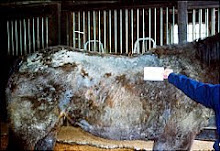
The Sentinel-Record/RICHARD RASMUSSEN Exercise rider Alex Brown heads back to trainer Steve Asmussen's barn after galloping a horse at Oaklawn Park on Wednesday. Brown is dedicated to finding a cure for laminitis, a circulatory foot disorder.
HOT SPRINGS - Alex Brown likes to ride horses and write about horses, but is passionate about saving horses.
"I feel like I've got my PhD in this," Brown said of his effort to save horses from slaughter.
Brown, 43, is chronicling his daily f ight through his Web site, www. alexbrownracing.com, dedicated to the legacy of 2006 Kentucky Derby winner Barbaro by improving horse welfare, finding a cure for laminitis, a circulatory disorder of the foot, and ending slaughter.
Brown's journey has brought him to Oaklawn Park, where he gallops horses for trainer Steve Asmussen.
"Everything I'm doing is a consequence of following Barbaro," Brown said. "Previously, I had spent the best part of 20 years in racing completely oblivious to horse slaughter and really little regard to horse welfare in general."
Barbaro was euthanized in January 2007 after developing laminitis, which developed after the colt broke multiple bones in his right hind leg shortly after the start of Preakness in May 2006.
Brown became attached to the story while galloping horses at Fair Hill Training Center in Maryland, where Barbaro was based much of his career.
An Internet marketing professor at the University of Delaware, Brown already was blogging on a site for local trainer Tim Woolley when Barbaro won the Kentucky Derby.
Two weeks later, the site unexpectedly became a mainstream news source.
"We built the traffic up to about 150 page views going into the Preakness," said Brown, a native of Manchester, England. "Then obviously, we know what happened in the Preakness. My initial reaction was to stop the project, because I wasn't going to exploit a very bad situation."
Brown said he was messing around on the site the following day and realized "everybody was Googling Barbaro and getting nothing."
Brown said after he broke a story concerning Barbaro's surgery, the site crashed after receiving 3,000 visits within an hour.
"Basically from then on, I just committed deliberately to providing updates if I could get them," Brown said. "That's how the project began."
Brown said he has a contract with Barbaro's owners, Roy and Gretchen Jackson, to write a book, Greatness and Goodness: Barbaro and His Legacy.
Brown said three-quarters of the book - 150 pages of pure text - is already on the Internet.
"It's more to establish that Barbaro is great, and then talk about the good things that have occurred as a result of Barbaro, which would be horse slaughter, horse rescue, issues related to horse racing," Brown said.
A little over a year ago, Brown cut his roots and left Fair Hill (he had been based there for 20 years) to tour North America to get a better handle on those issues at a local level.
The easiest way to do that, Brown said, was to work for a trainer and move when the horses moved to another track.
Brown galloped horses at Penn National and Presque Isle in Pennsylvania and at Keeneland and Churchill Downs in Kentucky before going to work exclusively for Asmussen in November 2007 at Sam Houston Race Park in Texas.
Brown also galloped horses last year at Woodbine in Canada. Now he's at Oaklawn for the first time.
Although he's in Arkansas, Brown still runs his Web site, which, in the past two years, has raised more than $1 million to rescue approximately 2,700 horses from the horse slaughter pipeline.
Brown said the site has had almost a million messages posted.
One of the site's recent success stories is Clever Allemont, who won Oaklawn's Rebel and Southwest stakes in 1985 for trainer Lynn Whiting and owner Cal Partee of Magnolia.
Clever Allemont was discovered in a kill pen late last year in Kansas.
Roughly a half-hour after the story was posted on Brown's site, a forum reader donated funds to purchase Clever Allemont from the dealer who sells horses for slaughter.
Clever Allemont is now at Old Friends, a facility for retired thoroughbreds in Georgetown, Ky.
"If any horseman can argue to me that Clever Allemont should be slaughtered, I don't think so," Brown said. "The fact that slaughter is an option puts horses like that at risk. It was purely by chance that a horse rescue was going to that kill pen to go look for a palomino pony, and the kill buyer talked to that rescue and said, 'Look, I've got this old thoroughbred, I really don't want to send him to kill. Will you take it?'
"Even the kill buyer's compassionate enough to realize that horses shouldn't be slaughtered."
Slaughterhouses in Texas and Illinois have closed in recent years, but they are still prevalent in Canada and Mexico.
"The issue is quite complicated, and I think the pro-slaughter lobbies have done a good job convincing people slaughter is necessary," Brown said. "But as a horseman, I know it's not necessary and I certainly know it's not right."

















1 comment:
Horse slaughter is cruel and inhumane for other people but for others, it is the only way to stop the overcrowd population of horses. Horse slaughter is one of the scariest word in horsemanship.
Post a Comment